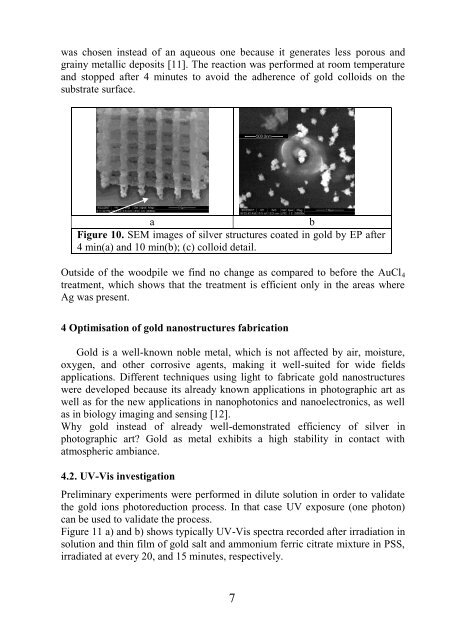Ph. D. THESIS 2009
Ph. D. THESIS 2009
Ph. D. THESIS 2009
You also want an ePaper? Increase the reach of your titles
YUMPU automatically turns print PDFs into web optimized ePapers that Google loves.
was chosen instead of an aqueous one because it generates less porous and<br />
grainy metallic deposits [11]. The reaction was performed at room temperature<br />
and stopped after 4 minutes to avoid the adherence of gold colloids on the<br />
substrate surface.<br />
a b<br />
Figure 10. SEM images of silver structures coated in gold by EP after<br />
4 min(a) and 10 min(b); (c) colloid detail.<br />
Outside of the woodpile we find no change as compared to before the AuCl4<br />
treatment, which shows that the treatment is efficient only in the areas where<br />
Ag was present.<br />
4 Optimisation of gold nanostructures fabrication<br />
Gold is a well-known noble metal, which is not affected by air, moisture,<br />
oxygen, and other corrosive agents, making it well-suited for wide fields<br />
applications. Different techniques using light to fabricate gold nanostructures<br />
were developed because its already known applications in photographic art as<br />
well as for the new applications in nanophotonics and nanoelectronics, as well<br />
as in biology imaging and sensing [12].<br />
Why gold instead of already well-demonstrated efficiency of silver in<br />
photographic art? Gold as metal exhibits a high stability in contact with<br />
atmospheric ambiance.<br />
4.2. UV-Vis investigation<br />
Preliminary experiments were performed in dilute solution in order to validate<br />
the gold ions photoreduction process. In that case UV exposure (one photon)<br />
can be used to validate the process.<br />
Figure 11 a) and b) shows typically UV-Vis spectra recorded after irradiation in<br />
solution and thin film of gold salt and ammonium ferric citrate mixture in PSS,<br />
irradiated at every 20, and 15 minutes, respectively.<br />
7
















